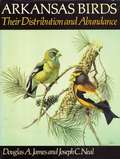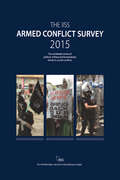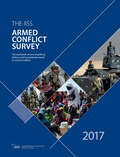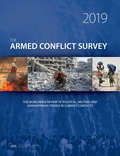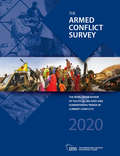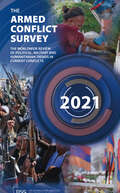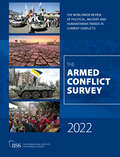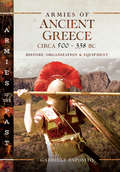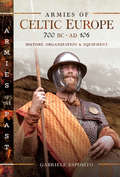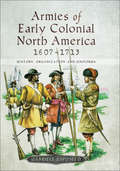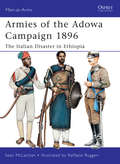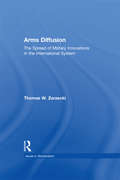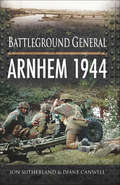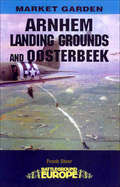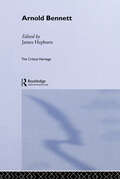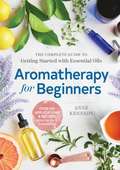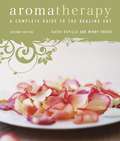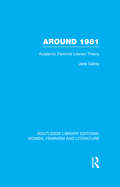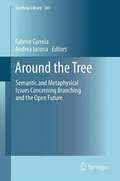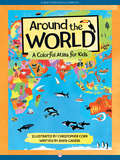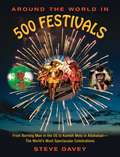- Table View
- List View
Arkansas Birds: Their Distribution and Abundance
by Douglas A. James Joseph C. NealThis edition has an in-depth reference work on Arkansas birds. It includes interesting quotations from 19th -century ornithologists and nature historians as well as evidence from more recent research.
Armed Conflict Survey (Armed Conflict Survey Ser.)
by Nigel InksterThis book provides data on fatalities, refugees and separated people for all major armed conflicts in the Middle East, Sub-Saharan Africa, South Asia, Asia-Pacific, Europe and Eurasia, and Latin America in 2015, alongside in-depth analysis of their political, military and humanitarian dimensions.
Armed Conflict Survey 2017 (Armed Conflict Survey Ser.)
by The International Institute for Strategic StudiesThe Armed Conflict Survey provides in-depth analysis of the political, military and humanitarian dimensions of all major armed conflicts, as well as data on fatalities, refugees and internally displaced persons. Compiled by the IISS, publisher of The Military Balance, it is the standard reference work on contemporary conflict. The book assesses key developments in 36 conflicts, including those in Iraq, Syria, Afghanistan, South Sudan, Israel–Palestine, Southern Thailand, Colombia and Ukraine.The Armed Conflict Survey also features chapters on UN peacekeeping; sexual violence; the Islamic State’s shifting narrative; governance by armed groups and rebel-to-party transitions.
Armed Conflict Survey 2019
by The International Institute for Strategic StudiesThe Armed Conflict Survey provides in-depth analysis of the political, military and humanitarian dimensions of all major armed conflicts, as well as data on fatalities, refugees and internally displaced persons. Compiled by the IISS, publisher of The Military Balance, it is the standard reference work on contemporary conflict. The book assesses key developments in 36 high-, medium- and low-intensity conflicts, including those in Iraq, Syria, Afghanistan, South Sudan, Israel–Palestine, Southern Thailand, Colombia and Ukraine. The Armed Conflict Survey features essays by some of the world’s leading experts on armed conflict, including Mats Berdal, Elisabeth Jean Wood, Julia Bleckner, Nelly Lahoud, William Reno and Carrie Manning. They write on: • UN peacekeeping; • conflict-related sexual violence; • the Islamic State’s shifting narrative; • the changing foundations of governance by armed groups; and • rebel-to-party transitions. The authors’ discussion of principal thematic and cross-national trends complements the detailed analysis of each conflict at the core of the book. The Armed Conflict Survey also includes maps, infographics and multi-year data, as well as the IISS Chart of Conflict.
Armed Conflict Survey 2020
by The International Institute for Strategic StudiesThe Armed Conflict Survey is the annual review of the political, military and humanitarian dimensions of all active conflicts from the International Institute for Strategic Studies. It offers in-depth analysis of the drivers, dynamics and impact of 33 current wars along with detailed information on conflict parties and more than 60 full-colour maps and infographics. The Armed Conflict Survey is an essential resource for those involved in security policymaking, and an indispensable handbook for anyone conducting serious analysis of armed conflict. Key features · Essays on global trends in armed conflict with a focus on armed groups and their increasingly horizontal structures, adaptability and propensity for exploiting technology. · Overviews of key events and political and military developments in 2019 for each conflict. · In-depth analysis of the underlying drivers and historical roots of conflicts. · Expanded information on conflict parties. · New timelines showing the key political and military developments of 2019. · Analysis of the humanitarian, social and economic impact of conflicts. · Conflict-specific trends, strategic implications and prospects for peace. · More than 60 full-colour maps, tables and infographics highlighting key conflict developments and data. · Key statistics on refugees, internally displaced persons and people in need. · The 2020 Chart of Armed Conflict, providing an overview of conflict actors including state forces, armed groups and multinational missions to conflict and post-conflict countries.
Armed Conflict Survey 2021
by The International Institute for Strategic StudiesThe Armed Conflict Survey is the annual review of the political, military and humanitarian dimensions of all active conflicts from the International Institute for Strategic Studies. It offers in-depth analysis of the drivers, dynamics and outlook of 34 current armed conflicts along with detailed information on conflict parties and more than 60 full-colour maps and infographics. The Armed Conflict Survey is an essential resource for those involved in security, foreign and humanitarian policymaking, and an indispensable handbook for anyone conducting serious analysis of armed conflict. Key features · Essays on global trends in armed conflict, with a focus on the changing nature of third-party intervention, the long aftermath of armed conflicts, and economic migration and forced displacement in a COVID-19 world. · Overviews of key events and political and military developments from January 2020–February 2021 for each conflict. · Strategic analysis of national and regional drivers and conflict outlooks. · Regional analyses with unique insights into the geopolitical and geo-economic threads linking conflicts across regions and globally. · Expanded information on conflict parties. · The Armed Conflict Global Relevance Indicator (ACGRI), an IISS proprietary indicator that combines measures of incidence and human impact with geopolitical impact to assess the global salience of armed conflicts. · Analysis of the humanitarian, social and economic impact of conflicts. · Conflict-specific trends, strategic implications and prospects for peace. · More than 60 full-colour maps, tables and infographics highlighting key conflict developments and data. · Key statistics on violent events, fatalities, military power, geopolitical salience, refugees and internally displaced persons. · The 2021 Chart of Armed Conflict, presenting information on conflict start dates, typologies and relevant refugee flows, as well as providing a visual overview of each conflict’s geopolitical relevance, looking at 2020 UN Security Council resolutions, multilateral missions and the involvement of third-party countries.
Armed Conflict Survey 2022
by The International Institute for Strategic StudiesThe Armed Conflict Survey 2022 provides an exhaustive review of the political, military and humanitarian dimensions of 33 active armed conflicts globally in the period from 1 March 2021 to 30 April 2022. The review is complemented by a strategic analysis of national, regional and global drivers and conflict outlooks, providing unique insights into the geopolitical and geo-economic threads linking conflicts across the world, as well as into emerging flashpoints and political risks. This edition includes a special feature on climate security given the increasingly urgent need to understand the complex interlinkages between climate change, climate vulnerability and conflict amid accelerating global warming. Reflecting the growing importance of geopolitical factors in the current global conflict landscape, The Armed Conflict Survey 2022 features the IISS Armed Conflict Global Relevance Indicator, which compares the global relevance of armed conflicts in terms of their geopolitical impact, as well as their human impact and intensity. This edition also includes maps, infographics and key statistics, as well as the accompanying Chart of Armed Conflict.
Armies of Ancient Greece Circa 500–338 BC: History, Organization & Equipment (Armies Of The Past Ser.)
by Gabriele EspositoIllustrated with color photos, this guide details the arms, armor, organization, and tactics of Classical Greek armies.The Classical period includes some of the most famous wars and battles of Ancient Greece, including the defeat of the Persians at Marathon, the Spartans’ last stand at Thermopylae, the Peloponnesian War and the March of the Ten Thousand. The Greek heavy infantry spearmen, or hoplites, are one of the most recognizable types of ancient warrior and their tightly-packed phalanx formation dominated the battlefield.Covering the period from the Persian Wars to the Macedonian victory at the Battle of Chaeronea, Gabriele Esposito examines the famous hoplites heavy infantry as well as other troops, such as light infantry skirmishers and cavalry. His clear, informative text is beautifully illustrated with dozens of color photographs showing how the equipment was worn and used.
Armies of Celtic Europe, 700 BC–AD 106: History, Organization & Equipment (Armies of the Past)
by Gabriele EspositoA look at the military might of these ancient warriors who sacked Rome and conquered much of Europe. Although comprised of many distinct tribes and groupings, the Celts shared a distinctive culture that dominated much of Europe for centuries, and enjoyed a formidable reputation as fierce and brave warriors, skilled horsemen, and fine metalworkers. In 390 BC, an alliance of Celtic tribes defeated a Roman army at the River Allia and went on to sack Rome and thenceforth the Romans lived under their threat. In the early third century BC, a Celtic army swept into Macedonia and Greece, won a major victory at Thermopylai, and ransacked the sacred sanctuary at Delphi. Such was their warlike prowess that, when not fighting their own wars, they were sought after as mercenaries by many armies, serving as far afield as southern Egypt. When the Romans invaded Gaul—modern-day France and Belgium—and the British Isles, Celtic armies resisted them fiercely. In this book, Gabriele Esposito studies this fascinating warrior culture, their armies, strategy, tactics, and equipment—they invented the horned saddle and chainmail, and British armies were the last in Europe to use chariots on the battlefield. Also included are dozens of color photographs of reenactors to help bring these magnificent warriors back to life.
Armies of Celtic Europe, 700 BC–AD 106: History, Organization & Equipment (Armies of the Past)
by Gabriele EspositoA look at the military might of these ancient warriors who sacked Rome and conquered much of Europe. Although comprised of many distinct tribes and groupings, the Celts shared a distinctive culture that dominated much of Europe for centuries, and enjoyed a formidable reputation as fierce and brave warriors, skilled horsemen, and fine metalworkers. In 390 BC, an alliance of Celtic tribes defeated a Roman army at the River Allia and went on to sack Rome and thenceforth the Romans lived under their threat. In the early third century BC, a Celtic army swept into Macedonia and Greece, won a major victory at Thermopylai, and ransacked the sacred sanctuary at Delphi. Such was their warlike prowess that, when not fighting their own wars, they were sought after as mercenaries by many armies, serving as far afield as southern Egypt. When the Romans invaded Gaul—modern-day France and Belgium—and the British Isles, Celtic armies resisted them fiercely. In this book, Gabriele Esposito studies this fascinating warrior culture, their armies, strategy, tactics, and equipment—they invented the horned saddle and chainmail, and British armies were the last in Europe to use chariots on the battlefield. Also included are dozens of color photographs of reenactors to help bring these magnificent warriors back to life.
Armies of Early Colonial North America, 1607–1713: History, Organization and Uniforms
by Gabriele EspositoGabriele Esposito presents a detailed overview of the military history of Colonial North America during its earliest period, from the first colonial settlement in Jamestown to the end of the first continental war fought in the Americas. He follows the development of organization and uniforms not only for the British Colonies of North America but also for the French ones of Canada. Every colonial unit formed by the Europeans in the New World, as well as the regular troops sent to America by Britain and France, is covered in detail: from the early militias of the Thirteen Colonies to the expeditionary forces formed during the War of the Spanish Succession. Great military events, like King Philips War or Bacons Rebellion, are analyzed and the evolution of tactics employed in this theater are discussed, showing how much warfare was influenced by the terrain and conditions in North America. Dozens of illustrations, including color art works, show the first military uniforms ever worn in North America, as well as interesting details of weaponry and equipment used.
Armies of the Adowa Campaign 1896
by Sean Mclachlan Raffaele RuggeriIn the late 19th century, the new nation-state of Italy was eager to join her European neighbors in creating an international empire. Italy's eyes turned towards Africa as a source of potential colonies. Most of the continent had already been carved up between the Great Powers but Italy succeeded in securing a foothold in Eritrea on the Red Sea coast, a vassal of the Emperor of Ethiopia. Trade and other links were established with the Ethiopian empire but quarrels regarding the interpretation of a particular clause led to Ethiopian support for uprisings in Eritrea. Italian troops entered northern Ethiopia and captured Adowa, the capital of the Tigray province. Full-scale war broke out and this new Osprey title tracks every development in the battle and the men who fought in it.From the Trade Paperback edition.
Arms Diffusion: The Spread of Military Innovations in the International System (Issues in Globalization)
by THomas W. ZarzeckiWeapons proliferation is one of the most pressing global concerns following the end of the Cold War. Despite the absence of an overarching superpower conflict, armaments and related technologies have continued to spread throughout the international system. This has been particularly true in areas like East Asia and the Middle East, where the traditional two party arms races are not readily apparent. This text addresses these concerns and shortcomings using data on fourteen specific military technological innovations that diffused throughout the international system from 1960 to 1997.
Army of Charles II
by John ChildsFirst published in 2006. Routledge is an imprint of Taylor & Francis, an informa company.
Arnhem 1944: Arnhem 1944 (Battleground General Ser.)
by Diane Canwell Jon SutherlandThis is the first in a series of game books which put you in command of the forces in engaged in some of history's most famous battles. Your tactical skill and ability to make the right command decision will be tested at every turn of the page. Operation Market Garden in September 1944 was one of the most daring Allied plans of the Second World War. An audacious surprise assault from the air, it was intended to give the Allies a bridgehead across the Rhine, removing the last significant natural barrier on the road to Berlin. If successful it might have shortened the war by months. Will the brave British paratroopers be able to seize the vital bridge at Arnhem and hold it until reinforcements fight their way through? Or will the Germans be able to recover the initiative and crush them in a skillful counterattack? The book presents you with a series of command decisions, aided by situation maps; directing you to the next relevant briefing depending on the option you choose. No dice are necessary to play, just this book and your tactical skill. When you buy this book, the fate of nations is in your hands.
Arnhem: Landing Grounds And Oosterbeek (Battleground Europe)
by Frank SteerThis is the latest in the well-respected Battleground series of books, and covers a number of aspects of the battle of Arnhem. It concentrates on the landings and the desperate and legendary battle fought by the remnants of 1st Airborne Division in the town of Oosterbeek. The book relies on both historical knowledge and anecdotes from veterans to bring to life the events of those fateful days of late September 1944.Having set the strategic scene in the opening chapter, the guide suggests four separate tours around the area, one on foot and the others requiring a car. They can all be completed in a full day, but are structured in such a way that visitors can make their own choice of how and where to visit. For a clear, concise and accurate account of the Arnhem-Oosterbeek battlefield this excellent addition to our Battleground series is unlikely to be beaten.
Arnold Bennett
by James HepburnThis set comprises fory volumes covering nineteenth and twentieth century European and American authors. These volumes will be available as a complete set, mini boxed sets (by theme) or as individual volumes. This second set compliments the first sixty-eight volume set of Critical Heritage published by Routledge in October 1995.
Aromatherapy For Beginners: The Complete Guide To Getting Started With Essential Oils
by Anne Kennedy Clara LeeExplore the multitude of benefits of essential oils and aromatherapy: In her clear and positive voice, Worwood provides tools to address a variety of health issues, including specific advice for children, women, men, and seniors. This aromatheraphy book also covers self-defense against microbes and contaminants, emotional challenges, care for the home and workplace, and applications for athletes, dancers, travelers, cooks, gardeners, and animal lovers. Worwood also offers us her expertise in the use of essential oils in beauty and spa treatments, plus profiles of 125 essential oils, 37 carrier oils, and more.
Aromatherapy: A Complete Guide to the Healing Art [An Essential Oils Book]
by Kathi Keville Mindy GreenA comprehensive guide to using essential oils in health, beauty, and well-being. Aromatherapy offers countless uses, from cosmetics to therapeutics for balancing body, mind, and spirit. Drawing on 75 combined years of experience in botanical therapies, Keville and Green update their complete guide with the latest information for aromatherapy practitioners and students, providing an invaluable resource that includes more than 90 formulas for using essential oils in health and first aid, skin and hair care, massage, relaxation, and more.From the Trade Paperback edition.
Around 1981: Academic Feminist Literary Theory (Routledge Library Editions: Women, Feminism and Literature)
by Jane GallopJane Gallop’s book offers a clear-eyed and comprehensive history of feminist literary criticism. Why, she asks, have we so quickly buried 1970s feminist criticism? What lies buried there? Why do 1990s academic feminists accuse other academic feminists of being ‘academic’? Gallop takes the novel approach of structuring her inquiry around anthologies of feminist criticism: twelve important texts that have had a wide impact on more than a decade of scholarship. In reading an anthology as a whole, she typically identifies a central, hegemonic voice (usually that of the editor/s) which would organise all the voices into a unity, and then explores the resistance within that volume to such a unity. Weight is placed behind these internal differences as a wedge against the centrist drive. Around 1981 addresses briefly ‘french feminism’ and psychoanalytic feminism before focusing on its principal subject: the mainstream of feminist literary criticism, before and after its general acceptance as part of the changing institution of literary studies. This brilliantly illuminates the dilemma of the feminist critic, divided by her allegiance to both feminism and literary studies.
Around the Tree: Semantic and Metaphysical Issues Concerning Branching and the Open Future (Synthese Library #361)
by Fabrice Correia Andrea IaconaOver the past few years, the tree model of time has been widely employed to deal with issues concerning the semantics of tensed discourse. The thought that has motivated its adoption is that the most plausible way to make sense of indeterminism is to conceive of future possibilities as branches that depart from a common trunk, constituted by the past and the present. However, the thought still needs to be further articulated and defended, and several important questions remain open, such as the question of how actuality can be understood and formally represented in a branching framework. The present volume is intended to be a 360 degree reflection on the tree model. The contributions is gathers concern the model and its alternatives, both from a semantic and from a metaphysical point of view.
Around the World
by Anita Ganeri Christopher CorrA lively illustrated introduction to the countries of the world and the seven continents, this bright, playful atlas gives inquisitive readers just enough information to whet the appetite for exploration. Sprinkled with imagery that picks out a country's unique essence--like the giant squid and penguins of Antarctica, and a dragonfly-shaped kite from Vietnam's International Kit Festival--and trivia that informs, this atlas makes a great gift for curious kids.This is a fixed-format ebook, which preserves the design and layout of the original print book.
Around the World in 500 Festivals: From Burning Man in the US to Kumbh Mela in Allahabad?The World?s Most Spectacular Celebrations (Culture Smart! Ser.)
by Steve DaveyThousands of festivals take place around the world every year. Some have cult followings with tickets that sell out instantly-forty thousand Burning Man tickets sold out in a manner of minutes-some are thrown in little-known faraway places-cities in Benin or San Marino.In this unique volume, Steve Davey, author of the 300,000+ selling book Unforgettable Places to See Before You Die, has created the ultimate, unparalleled book on the subject, showcasing a whopping 500 festivals in 121 countries-far and away more than any other book of its kind. To make it, he traveled the world, comprehensively researched its most dynamic events, and carefully selected the festivals with the most extraordinary highs, a life-affirming buzz.The result is scene-setting descriptions and 270 complementary jaw-dropping photographs-colorful images on every page. It’s an energetic celebration of events from Carnival in Rio to the Full Moon Party in Thailand, from the most brilliant Day of the Dead celebrations to the gooiest food fights, the most over-the-top costumes to the most daring displays of bravado.For ease of reference, the festivals are organized by continent, by region, then alphabetically by country. With dates and locations, they’re made accessible to those looking to enhance upcoming trips and those looking for their next big adventure. The compilation is also an instant thrill for the armchair traveler-immediate access to the world’s most joyful events.Around the World in 500 Festivals was published in a limited print-run in 2013. It’s now being given a comprehensive update and new packaging-a thrilling new offering for readers looking to experience new places and cultures when they’re most alive.
Around the World in 80 Birds
by Mike UnwinThis beautiful and inspiring book tells the stories of 80 birds around the world: from the Sociable Weaver Bird in Namibia which constructs huge, multi-nest 'apartment blocks' in the desert, to the Bar-headed Goose of China, one of the highest-flying migrants which crosses the Himalayas twice a year.Many birds come steeped in folklore and myth, some are national emblems and a few have inspired scientific revelation or daring conservation projects. Each has a story to tell that sheds a light on our relationship with the natural world and reveals just how deeply birds matter to us.
Around the World in 80 Birds
by Mike UnwinThis beautiful and inspiring book tells the stories of 80 birds around the world: from the Sociable Weaver Bird in Namibia which constructs huge, multi-nest 'apartment blocks' in the desert, to the Bar-headed Goose of China, one of the highest-flying migrants which crosses the Himalayas twice a year.Many birds come steeped in folklore and myth, some are national emblems and a few have inspired scientific revelation or daring conservation projects. Each has a story to tell that sheds a light on our relationship with the natural world and reveals just how deeply birds matter to us.
